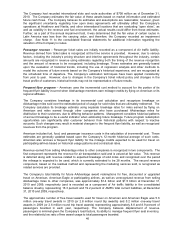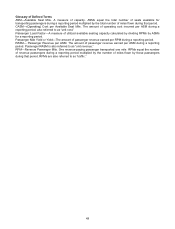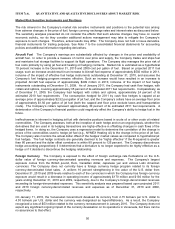American Airlines 2010 Annual Report Download - page 48
Download and view the complete annual report
Please find page 48 of the 2010 American Airlines annual report below. You can navigate through the pages in the report by either clicking on the pages listed below, or by using the keyword search tool below to find specific information within the annual report.
45
Other Information
Critical Accounting Policies and Estimates The preparation of the Company’s financial statements in
conformity with U.S. Generally Accepted Accounting Principles (U.S. GAAP) requires management to make
estimates and assumptions that affect the amounts reported in the consolidated financial statements and
accompanying notes. The Company believes its estimates and assumptions are reasonable; however, actual
results and the timing of the recognition of such amounts could differ from those estimates. The Company has
identified the following critical accounting policies and estimates used by management in the preparation of the
Company’s financial statements: long-lived assets, routes, passenger revenue, frequent flyer program, stock
compensation, pensions and retiree medical and other benefits, income taxes and derivatives accounting.
Long-lived assets – The Company has approximately $16 billion of long-lived assets as of December 31,
2010, including approximately $15 billion related to flight equipment and other fixed assets. In addition to
the original cost of these assets, the recorded value of the Company’s fixed assets is impacted by a number
of estimates made by the Company, including estimated useful lives, salvage values and the Company’s
determination as to whether aircraft are temporarily or permanently grounded. In accordance with U.S.
GAAP, the Company records impairment charges on long-lived assets used in operations when events and
circumstances indicate that the assets may be impaired, the undiscounted cash flows estimated to be
generated by those assets are less than the carrying amount of those assets and the net book value of the
assets exceeds their estimated fair value. In making these determinations, the Company uses certain
assumptions, including, but not limited to: (i) estimated fair value of the assets; and (ii) estimated future
cash flows expected to be generated by the assets, generally evaluated at a fleet level, which are based on
additional assumptions such as asset utilization, length of service and estimated salvage values. A change
in the Company's fleet plan has been the primary indicator that has resulted in an impairment charge in the
past.
The majority of American’s fleet types are depreciated over 30 years. It is possible that the ultimate lives of
the Company’s aircraft will be significantly different than the current estimate due to unforeseen events in
the future that impact the Company’s fleet plan, including positive or negative developments in the areas
described above. For example, operating the aircraft for a longer period will result in higher maintenance,
fuel and other operating costs than if the Company replaced the aircraft. At some point in the future, higher
operating costs, including higher fuel expense, and/or improvement in the Company’s economic condition,
could change the Company’s analysis of the impact of retaining aircraft versus replacing them with new
aircraft.
In the fourth quarter of 2009, due to the continuing severe downturn in the global economy and weakness in
the regional jet aircraft market, the Company’s plan to sell certain of its Embraer RJ-135 aircraft was no
longer feasible at the amount for which these aircraft had been valued. Consequently, the Company
reclassified these aircraft from held for sale to held for use, tested them for impairment and concluded the
carrying values of certain of its Embraer RJ-135 aircraft were no longer recoverable.
In the second quarter of 2008, due to the Company’s capacity reduction announcement, the Company
concluded a triggering event had occurred and required that fixed assets be tested for impairment. As a
result of that testing, the Company recorded impairment charges related to its McDonnell Douglas MD-80
aircraft and Embraer RJ-135 aircraft. See Note 2 to the consolidated financial statements for more
information.
International Slots and Route Authorities – AMR performs annual impairment tests on its international
slots and route authorities, which are indefinite life intangible assets and as a result they are not amortized.
As discussed above, the Company also performs impairment tests when events and circumstances indicate
that the assets might be impaired. These tests are primarily based on estimates of discounted future cash
flows, using assumptions based on historical results adjusted to reflect the Company’s best estimate of
future market and operating conditions and also consideration of markets for these assets. The net
carrying value of assets not recoverable is reduced to fair value. The Company's estimates of fair value
represent its best estimate based on industry trends and reference to market rates and transactions.
During 2009, the Company adopted guidance on measuring the fair value of assets and liabilities. The
guidance introduces a framework for measuring fair value primarily based on exit prices and expands
required disclosure about fair value measurements of assets and liabilities.
























